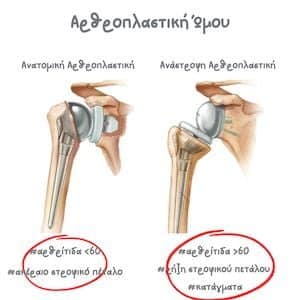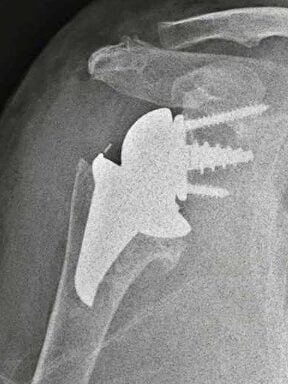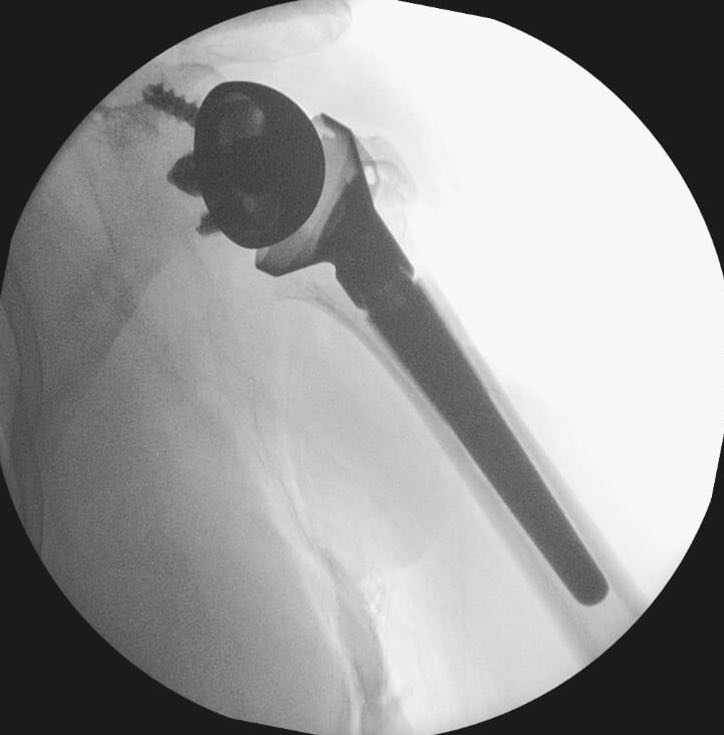Georgios Panagopoulos MD | Orthopaedic Surgeon

Shoulder arthroplasty is a procedure that replaces the damaged surfaces of the shoulder joint with artificial components, or implants, thus eliminating the source of pain and dysfunction. Most common indications include osteoarthritis, cuff arthropathy, and fractures.
Table of contents
What is shoulder arthroplasty?
The shoulder is a ball-and-socket joint. The round head (or humeral head) of the arm bone (humerus) is the “ball” that fits (articulates) with a surface on the shoulder blade, which is called the glenoid, and represents the socket of the shoulder joint. Conditions that erode the ball and socket and damage the joint, such as osteoarthritis, may lead to pain, stiffness and dysfunction of the arm. This is a major source of disability for patients. Shoulder arthroplasty (or replacement) is a procedure that replaces the damaged ball, socket or both with artificial components or implants, thus eliminating the source of pain and dysfunction.

What are the different types of shoulder arthroplasty?
There are two main types of shoulder arthroplasty or replacement surgery. In Total Shoulder Arthroplasty (TSA, also called anatomic total shoulder arthroplasty), the surgeon replaces the diseased part of your bones with an implant made of metal and plastic. The diseased “ball” of your joint is resected and replaced by a metal implant, either stemless or with a small stem, based on the situation. The diseased “socket” is replaced with a polyethylene cup. This procedure is typically performed in patients with an intact rotator cuff. In Reverse Total Shoulder Arthroplasty (rTSA), the surgeon “reverses” the location of the ball and socket. A metal head attaches to your shoulder blade and a socket attaches to your humerus. This provides a better level arm, improving your range of motion and reducing your pain. This procedure is typically performed in patients with a torn rotator cuff, as a TSA would not work in such cases. It is also preferred in a shoulder fracture situation.

Other types of shoulder arthroplasty include resurfacing, as well as shoulder hemiarthroplasty.
Why is shoulder arthroplasty performed?
The indications for performing shoulder arthroplasty may include the following:
- Osteoarthritis
- Rheumatoid arthritis
- Avascular necrosis
- Rotator cuff arthropathy
- Massive irreparable rotator cuff tears
- Trauma – proximal humerus fractures and post-traumatic arthritis
- Previous failed rotator cuff repair or failed ORIF

You may be a candidate for shoulder arthroplasty if you have the following:
- Severe pain and reduced motion that prevents you from performing your regular activities of daily living or recreational activities
- You have consistent reduced motion and weakness in your shoulder
- You have significant pain that disturbs your sleep
- Conservative treatment, such as rest, physiotherapy or cortisone injections has failed to provide more than temporary relief
- You had prior surgery, such as arthroscopic cuff repair or fracture fixation, that failed to heal properly or address your symptoms

What happens before the procedure?
Before shoulder arthroplasty, you will typically undergo preoperative assessment. You will be asked about your health history in detail. You will be asked to bring along a full list of your medications. You may need to stop taking some of your medications a few days before surgery (especially blood thinners). Before the procedure, you may also need blood tests, a chest x-ray and an ECG (electrocardiogram) or cardiology consult, to make sure it’s safe to proceed with surgery. The anaesthetist will give you specific preoperative instructions, including how long before surgery to stop eating and drinking. Typical recommendations usually suggest no eating or drinking at least six hours prior to surgery.
Admission to hospital - Anaesthesia
Admission to hospital occurs the day of surgery. Shoulder arthroplasty is performed under general anesthesia +/- regional nerve block, which provides pain relief postoperatively for 12-18 hours. Be prepared to stay overnight in the hospital.
What happens during the procedure?
Shoulder arthroplasty usually lasts approximately 90 minutes, which may vary depending on the complexity of the procedure. It is typically performed under general anaesthetic + regional block (interscalene) but may be done only under regional block, in selected cases. During the procedure, you will be placed in a semi-seated (beach chair) position. The shoulder replacement is performed through a 10 cm incision in the front of your shoulder. After placement of the implants, the wound is closed with buried dissolvable sutures and steristrips. The wound will be covered with a waterproof dressing, but the wound shoulder kept dry for 10-14 days. Your arm with be placed in a sling, to be kept for 3 weeks.



What to expect after the procedure?
Shoulder arthroplasty usually involves an overnight stay. The regional nerve block provides pain relief for 12-18 hours. Oral analgesics with be provided upon discharge for pain relief at home. The physiotherapist with give you an early home exercise program to avoid stiffness. Your arm with be placed in a sling, to be kept for 3 weeks, after which formal outpatient physiotherapy may start. The wound should be kept dry for 2 weeks, after which it is ok to wash. Return to work varies, based on the occupation, but it may be as soon as 2 weeks after the procedure. You may be unable to drive for a few weeks after the procedure – you must review your insurance policy. Light lifting may start after 6 weeks, but heavy lifting is usually allowed after 12 weeks. You should NOT lift yourself up from a chair or bed with the operated arm for 6 weeks after the surgery. Your first postoperative appointment with the surgeon will be 2-3 weeks after the surgery, for clinical review and repeat x-rays.
Dr Panagopoulos has extensive experience in both primary and revision shoulder replacement surgery and will discuss all options with you during your visit in the office.
Shoulder arthroplasty - Complications
There is no such thing as a surgical procedure with 100% success. As with every surgery, there are always risks and benefits, and when benefits outweigh the risks, we go ahead and offer it. As a rule of thumb, risks may include infection, bleeding, nerve & vascular damage, periprosthetic fracture, need for further surgery, medical or anaesthetic complications. In capable hands, risk of complications is low, 1-2%. It is important to choose an experienced surgeon with a track record.
Shoulder arthroplasty & costs
The cost of the procedure depends from the complexity of the underlying pathology, but is generally reasonable. Costs are related to the hospital stay, the implants used and the surgical fees. Patients with private insurance are covered based on their individual plans. Part of the cost is covered by the National Health System. Please contact us for further information.
FAQs - Frequently Asked Questions
What is shoulder arthroplasty?
Shoulder arthroplasty (or replacement) is a procedure that replaces the damaged ball, socket or both with artificial components or implants, thus eliminating the source of pain and dysfunction.
What are the different types of shoulder arthroplasty?
– Anatomic total shoulder arthroplasty
– Reverse total shoulder arthroplasty
What are the current indications?
– Osteoarthritis
– Avascular necrosis (AVN)
– Cuff arthropathy
– Massive cuff tears
– Trauma – proximal humerus fractures & post-traumatic arthritis
– Prior failed cuff repair or ORIF
What are the potential complications?
Shoulder arthroplasty is a safe procedure, with a low complication rate. Choose an experienced surgeon with a track record. Risks may include infection, bleeding, nerve & vascular damage, periprosthetic fracture, need for further surgery, medical or anaesthetic complications.
Find us
Book an appointment with us today
